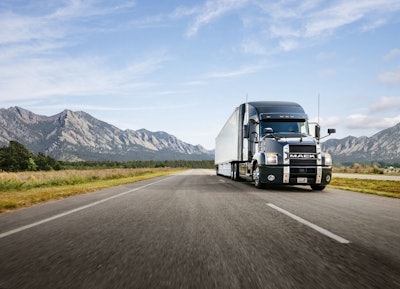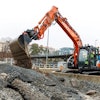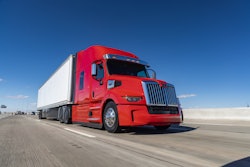
On a Saturday in early October, I watched as several Class 8 heavy-duty trucks with gravel fill zipped around a highway in Fond du Lac County, Wis., trying to wrap up a major project before winter. As I headed home westward on Highway 23, a Home Depot rental truck trailed my station wagon at a polite pace and came to a respectable stop behind my bumper, while I turned left onto a county highway. I glanced in the rearview mirror and saw the orange rental flatbed carried a skid-steer loader, possibly intended for finishing up commercial landscaping during Wisconsin’s waning early autumn warmth.
Upon my return home, I paused to wait for another Mack Granite to clear my subdivision, where it was working on a driveway job. Then, I received delivery of a cabinet out of a semi with a trailer length longer than my driveway. A few minutes later, a Spee-Dee Delivery walk-in delivery truck cruised up with a recurring bulk coffee order—and complimentary dog treats. I wasn’t counting then, but in retrospect, I had seven truck interactions within 30 minutes and did not find the drive home to be abnormal or the trucks excessive.
The proliferation of e-commerce deliveries and returns, infrastructure projects and the natural increased inclination to work on one’s property during the COVID-19 pandemic shutdown have all contributed to unprecedented amounts of trucks on the road and off highway. Simply put, trucking in 2022 looks dramatically different than it did two decades ago. The world has come to rely on its clothing, food, furniture and roads to be supplied by trucks.
However, the past three years has not made it easy for drivers and manufacturers to meet demand. From hurricanes, wildfires and floods complicating routes and endangering workers to an airborne virus shutting down many truck rest stops, driver burnout and retirement was inevitable. But here is a glass-half-full perspective: The past three years created a host of opportunities for trucking manufacturers and the trucking industry to innovate and profit from said changes and updated designs, leading to increased safety and reduced driver fatigue.
Increased Cab Comforts Put Truckers’ Rest First
The Federal Motor Carrier Safety Administration (FMCSA) hours of service (HOS) rules, which govern the amount of time drivers of commercial vehicles can spend on the road, aim to prevent fatigue and compromises to safety that can come from long hours and miles behind the wheel. On June 1, 2020, FMCSA published revised HOS regulations, which took effect as of Sep 29, 2020, specifically the updated sleeper berth provision.
Originally, the proposed sleeper berth provision mandated that the driver spend at least eight hours in the sleeper berth during the minimum 10-hour off-duty requirement—perhaps an attempt to make sure drivers were getting their recommended eight full hours of shut-eye, as prescribed by the National Sleep Foundation, American Academy of Sleep Medicine and countless other organizations concerned with adult human health.
This provision modifies the sleeper berth exception to allow a driver to meet the 10-hour minimum off-duty requirement by spending at least 7 hours of that period in the berth. This is combined with a minimum off-duty period of at least 2 hours spent inside or outside the berth, provided the two periods total at least 10 hours. Aside from the logistical challenges of being forced to spend eight hours in a sleeper berth—what if a loading or receiving dock is closed by the time the driver gets there at midnight? The sleeper berths themselves can be confining, isolating and often unsanitary. Additionally, if spending seven hours in a sleeper berth sounds uncomfortable, imagine what cab comforts were like several decades ago.
Updated creature comforts, like queen-sized sleepers, ultra-cushy drivers’ seats and mattresses, improved cab lighting and airflow, closets, microwaves, fridges, televisions, and personal touches make the seven-hour sleeper berth rest requirement more palatable for many long-haul truck drivers. Some sleeper cabs even boast composting portable toilets in a dedicated bathroom area. Kenworth, Peterbilt, Western Star, International and Mack (Volvo) Trucks all offer spacious sleeper cabs in their Class 8 trucks.
In its latest addition to its X-Series, Western Star’s all-new 57X on-highway truck offers four cab options to suit any application, including a day cab, 60-in. mid roof, 72-in. mid roof or 72-in. Stratosphere. All deliver comfort with leather seating. On sleeper models, an optional driver’s lounge with table and Murphy bed is available. Interior LED lighting supports performance and longevity. Numerous customization and bright finish options are available to tailor the truck to the owner or driver’s needs. Production is planned to begin in the first quarter of 2023 at DTNA’s Cleveland (N.C.) Truck Manufacturing Plant, but interested drivers can check out the current X-Series lineup trucks, including the new Western Star 47X and 49X models.
At a recent event in Allentown, Penn., I tried out Mack’s new Command Steer technology. Aside from the ease of steering and reduced jolting, one of the first features I noticed when hopping behind the wheel of a Mack Anthem 70-in. Standup sleeper with HE+ Aero package and Mack Command Steer was the roomy cab and comforting, well-suspended driver’s seat. The cab featured a neatly-made bed with decent-quality linens, backlighting, numerous cupholders and outlets and some clever storage.
“The mentality has changed, where it used to be, ‘Drive the truck.’ Now—it’s such a great thing—they recognize the drivers,” said Joe Serock, Northeast district manager for Mack Trucks, who accompanied me while I drove a Mack Anthem without the smoothing Command Steer technology and who witnessed me operating the first commercial vehicle I’ve ever driven. “We’ve seen that because, I mean, pick a company, pick a segment. There’s not this overwhelming supply of people that are doing this anymore.”
Serock was referencing the infamously tight labor market in trucking, construction and other skilled trades.
“You really want to try your best to invest back into them,” Serock said, referencing both the cushy cab and the new Mack Command Steer Technology, which aims to reduce driver fatigue and help contractors and mining companies retain truck-driving employees. “And that’s, I think, what this is—it’s really a recognition, investing back into the drivers to say, ‘Hey, look, we get it. What can we try and do to help them with that job?’”
Truck Technology Updates Aim to Recruit and Retain Drivers
Aside from cab comforts, as Serock pointed out, new technologies keep popping up in commercial truck designs as of late. From smoother steering to wider windows and better side view mirrors, truck design and performance innovations aim to recruit and retain drivers with an interest in a long-term job.
“Driving a heavy-duty construction truck is physically demanding on the body,” said Tim Wrinkle, Mack construction product manager. “Jobsites have uneven road conditions, which contribute to wear and tear on the driver. Mack Command Steer has been shown to reduce driver effort by 85 percent, improving jobsite safety and driver productivity.”
Mack Command Steer combines an electric motor with the Mack Granite model’s existing hydraulic steering. Multiple sensors throughout the truck monitor the terrain, driver inputs and environmental elements more than 2,000 times per second. Based on the collected data, the system provides variable steering effort through its electric motor, applying additional torque as needed to make it easier to keep the truck on the desired route.
“What it does is, because of that counter-torque that the Command Steer is putting into the steering gear, if it’s a windy road, you might be driving down the highway and in our normal steering situation, you’re turning the wheel to the left 45° because the wind is so bad and you’re trying to stay on the road,” explained Stu Russoli, Mack Trucks senior highway product manager. “With [Command Steer], you’re still keeping your steering wheel straight because it’s already counteracting that torque.”
Along with a significant reduction in driver steering efforts at slow speeds, Command Steer suppresses uneven terrain, such as potholes, dips and ruts. The system reacts to those irregularities by countering the steer force, smoothing the steering feedback and reducing steering wheel “kicks.”
“Drivers no longer need to fight the wheel when driving on severe terrain or during difficult weather conditions requiring a lot of steer effort,” Wrinkle said. “Mack Command Steer helps the driver maintain greater control of both on-highway and off-road applications at low speeds and high speeds.”
An additional benefit of Mack Command Steer is that the system features a unique return-to-zero capability that automatically returns the steering wheel to the center position in forward and reverse, helping to simplify tight maneuvers.
“In return-to-zero, basically, I mean, take backing up a trailer. When you make that turn, you’re coming around and you let go of the steering wheel and it comes back to straight ahead. You know you’re already lined up. You can make your adjustments very easily,” Russoli said, describing the return-to-neutral steering wheel feature of Command Steer. Russoli also emphasized that drivers no longer need to use forceful hand-over-hand steering to navigate through potholes and other rough terrain to return the steering wheel to zero and move forward smoothly in a straight-ahead position.
As I tried out the technology for myself, first in a Mack Granite loaded with 40,000 lbs. of crushed limestone and then in a Mack Anthem 70-inch sleeper, I noted the lack of jostling through large areas of crowned roads. As I traversed through parts of Easton Quarry, an H&K Group quarry in Easton, Penn., I remarked to Wrinkle and Russoli that driving my first commercial vehicle was not as difficult or as fatiguing as I thought it would be. Upon my return home to Wisconsin, my husband and a few co-workers asked how the experience was, and I said, “It felt like driving a minivan.”
Not many quarry workers would describe a gravel truck as riding like a minivan, with smooth rolling capabilities and the suspension to handle a pack of jumpy kids in a carpool, but with Mack Command Steer, perhaps that sentiment will change.
Medium-Duty Vehicles Put Safety First
Not only Class 8 truck manufacturers prioritize increased comfort and worker utility. The new 2023 Ford F-Series Super Duty pickups feature a swiveling desktop on the center console, for those who want a flat surface to work on while stopped at rest stops, and Max Recline seats that fold almost entirely horizontal downward for maximum comfort during nap breaks. The new standard 6.8-liter V8 gas engine also generates low-end torque to make starting on steep grades and merging onto highways easier.
While the new Ford F-Series Super Duty trucks will not be available until early 2023, renting a rugged, durable F-250 is always an option through Home Depot Rentals, along with renting dump trailers to get the job done safely and quickly.
“Renting our F250 flatbed pickup truck can offer the customer peace of mind that it’s built for the job. It removes the guesswork on whether or not a customer’s vehicle has the towing capacity required to pull one of our dump trailer rentals,” said Bryan Partridge, assistant merchant for The Home Depot Rental. “Our flatbed pickup trucks can tow up to 13,000 lbs., which includes most of the large equipment available at our rental centers.”
Aside from a global virus, truck manufacturers and rental companies also aim to supply equipment and commercial vehicles to help clean up recent natural disasters, specifically Hurricane Ian and recent flooding in the South.
“Pros across the Southeast are renting trucks to remove debris and transport materials into restoration and recovery zones after recent hurricanes,” Partridge said, referencing The Home Depot Rental’s offering of the F-250. “We have heard from customers that they don’t want to rent a truck where they are worried about possibly damaging the stock bed. Pros need a vehicle that is reliable and tough, and our truck rentals are built for the job.”
The bed walls and tailgate fold down for easy loading and unloading on the flatbed pickup truck, Partridge explained, good features for disaster cleanup crews, evacuating families and emergency response teams.
So, while the last 36 months have felt like an eternity for those in the trucking industry and supply chain, I am delighted to report that I’ve seen firsthand the progress manufacturers and industry experts are making to ease the burden of a big job. From cozy sleeping spaces to better safety, trucking innovations continue to augment and improve the industry.


















